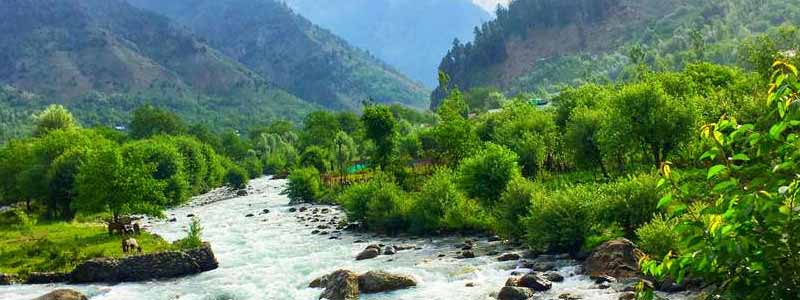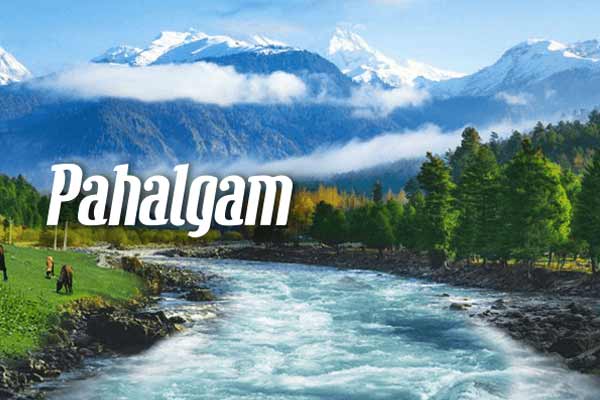Best Places to visit Pahalgam, also known as the “Valley of Shepherds,” located in Kashmir’s Anantnag district, is a retreat for nature lovers, which makes us believe paradise isn’t always far away. Sitting on the shoaming and gurgling banks of the Lidder River, this famous tourist spot in Cashmir captivates visitors with its lush meadows, lush forests, sky-kissing mountains, apple orchards, And truly peaceful surroundings.
It is ranked among Kashmir‘s top tourist destinations because it offers opportunities for camping, sightseeing, trekking, yatra pilgrimage, white water rafting and fishing.
A family vacation in Pahalgam is very exciting and you can do a lot of things to make your holiday a fun filled one. You can spend time by the Lidder River bank & enjoy Mother Nature’s blissful company. Other places where you can see Pahalgam’s awe-inspiring beauty are Aru & Betaab valleys and Bainsaran, dotted with meadows, lakes & streams.
Pahalgam is also popular as a spiritual destination because it is the starting point for the Amarnath Yatra, which is undertaken by Hindu pilgrims during the months of June & August, and starts at a town called Chandanwari, nearly 16 kilometres away.
Pahalgam is a haven for adventure enthusiasts, as they can enjoy camping in Tarsar Lake, Lidderwat, Kolahoi Glacier & Panchtarni. An ultimate adrenaline rush awaits you at Lidder River with white water rafting, which is also renowned for a fun-filled activity such as trout fishing.
Before planning a trip, get the most authentic information in this detailed Pahalgam travel guide, including how to reach, best time to visit, top tourist attractions & accommodation options. Plan a trip with India Tourism offered Pahalgam tour packages which are available at the best prices & deals.

Aru Valley
Aru Valley Pahalgam Region, Jammu and Cashmir, District, Anantnag, Altitude 2500 Meters (7,900 feet)Situated Southeast of Srinagar at a distance of 115 km from Srinagar town and 15 km from Pahalgam in Deep Peerpanjal ranges the Aru Valley is found. Pahalgam is an important tourist destination, and it enhances the importance of pahalgam for travellers. The Aru valley is surrounded by high Mountains peaks and woods den. The valley is a meeting point between two branches of Lidder River that come from the valley’s north and west. The valley is protected by a sanctuary for wildlife; it is home to distinctive wildlife, as well as brown bear, black bear, musk deer, leopard, snow leopard, wolfs and others.
Betaab Valley
Betaab Valley is a lovely spot located at Pahalgam‘s upper east side. This valley credited its name to the hit Bollywood movie Betaab, which was shot in its embracing beauty. The stunning geology of this valley is shaped by the sprawling rich knolls, snow-topped pinnacles and winding rivers. Apart from being a spot with vital geology, the valley is an excellent base for trekking and camping For travellers who are hoping to scout the good country districts around them. The segregated settings and the Betaab valley’s characteristic rich surroundings pull in some simply wedded couples, who are on a special first night visit to Kashmir.
Baisaran Hills
Surrounded by immensely wooded pine forests, Baisaran is a beautiful valley straight from films by Yash Chopra. Popularly known as India’s mini Switzerland, this meadow is only 5 kilometres from Pahalgam and easily reachable by pony. It also acts as a base for hikers who visit Tulian Lake. The way to Baisaran gives you a perfect photo opportunity while the ponies take you Through cross-country trails, lined with pine trees, up to the valley. There are not many food joints up there but tapries of small size, where they sell extremely good tea. In Pahalgam it is ideal for picnics and a must-visit attraction.
Awantipora
Awantipora or Awantipur is a city and a notified area committee in the Indian state of Jammu & Kashmir district of Pulwama. It is arranged on NH 44 previous name NH 1A between Anantnag and Srinagar, preceding renumbering of all national roadways. Awantipora was named after Avanti Varman, and the lord, including the Avantiswami Temple, had ious antiquated Hindu sanctuaries. In Awantipora the remains of sanctuaries developed by Lalitaditya are also found.
The local sanctuaries are secured and maintained by the Indian Archeological Survey. Awantipora has antique Hindu sanctuaries worked as his capital by King Awanti Varman AD 855-883 when he picked the site. Avantishwar sanctuary located at Jawbrari at the focus of a yard surrounded by a colonnaded peristyle is devoted to Siva on the banks of the Jhelum Vitasta River. Avantiswamin sanctuary, devoted to Vishnu, is not as much as a kilometre away.
In this sanctuary is said to be found the Vaikunta Vishnu delineated as frontispiece. The two sanctuaries are, fundamentally, very comparative. The passage dividers are adorned with designed reliefs both inside and away. In Awantipora, the vestiges of sanctuaries developed by Kashmir ‘s sovereign Lalitaditya are also situated.
Mamleshwar Temple
Religious texts allude to various reasons for having Lord Ganesha as the doorkeeper. One of the storeys says it was Mamleshwar Temple where Lord Ganesh stood for her mother as a doorkeeper, and did not allow Lord Shiva to enter her premises. So Lord Shiva cuts off his head without knowing that he was his own son and following the order of his mother.
This impressive stone building dates back to 400 AD and is about a kilometre from Pahalgam, resting in the mist-covered mountains. The complex is lush green and is located across the Kolahoi stream, another beautiful area attraction.
This temple is by no means big, and is internally barely under 8 square feet, has a porch in the 2 columns supported. It houses an old pedestal, and a Linga Shiva. Surprisingly, a spring of remarkably pure water rises from beneath the site of the temple and is enclosed in a basin opposite the stairs.
Tulian Lake
Tulian Lake is a lake and tourist destination in Pahalgam, in the Jammu and Kashmir state district of Anantnag, India. It is situated at an altitude of 3,353 metres above sea level, 16 km from Pahalgam and 11 km from Bai Saran. The lake often features ice chunks floating in it. On three sides it is surrounded by mountains which rise 300 metres above it and are usually covered with snow. It is located in a meadow dotted with pine forests.
Although there are several tourist places to visit in Pahalgam, this pristine body of water is unmatched in its allure. The lake lies among the mountain ranges of Zanskar and Pir Panjal and offers amazing views of the surrounding peaks. Mainly covered with snow, the Tulian Lake expedition is an ideal way to experience the charm of the Kashmir Valley. Its Baisaran route is full of challenges with no marked trekking trails and with some tough heights to scale.
Chandanwari
Chandanwari is renowned for being the base or point of departure for the famous Hindu pilgrimage site, Shri Amarnath Yatra, which begins in June and ends in August. It is located about 16 kilometres from Pahalgam, at an elevation of 2.895 metres. If you are looking for an off-beat tourist spot in Jammu and Cashmir where you can relax with nature, You ‘d have to visit this place then. It is blessed with picturesque beauty, with the Lidder River flowing nearby, and it is famous for its opportunities for sightseeing, as it is surrounded by snow-capped mountains. From November to May Chandanwari is covered in snow, and you can watch the beautiful sight of glaciers melting in the Lidder River.
Sheshnag Lake
The Sheshnag Lake is an oligotrophic lake (water body with low protoctist content and clear water of high quality), home to many species of fish along with brown trout. Thanks to its lush green meadows that surround it, the lake appears green in colour, creating a wide-ranging beauty to admire. With a measurement of 1,1 kilometres in length and 0,7 km in width, the lake is considered one of the most extensive stunning sights of Jammu and Kashmir tourism.
Sheshnag Lake is fed on top of it especially by the streams and snow mountains and it is always freezing in winter. Besides its scientific significance, the lake also has special meaning for Hindu followers. The lake is associated with numerous mythological storeys but the most commonly believed is that Sheshnag Lake belongs primarily to Sheshnag, the Lord of the Snakes, And it is alleged the Lord himself was creeping. Sheshnag Lake is also a sacred pilgrimage site, because of its presence on the way to the Holy Amarnath Cave. Travelers will just hike this must-visit tourist site from Chandanwadi Valley, which is just about 7 miles away. It is best to go to this lake between June and September when it is simply accessible and at the best of the scenery.
Amarnath Cave
Situated 29 km from Pahalgam, this site is one of the main reasons for the town’s tourist population. The only way to get to the temple of the Amarnath cave is to trek for 15 km. For Hindus, this is one of the holiest temples. This Shiva temple features a large ice-made Shivalinga. This cave is the place, where Lord Shiva explained the secrets of the universe according to mythology and immortality to Lord Parvathi.
Kolahoi Glacier
Kolahoi Glacier Trek is a classic Kashmir trek which takes us through lush green valleys, shady forest slopes fed by gushing streams, into an alpine meadow landscape and stunning views of the Himalayas all around. Kolahoi glacier is one of Jammu and Kashmir ‘s longest glaciers, and has extended for at least 35 km in the past. Kolahoi ‘s advances were three in the Pleistocene The glacier and the last one was an important advance when the glacier extended to Pahalgam. The Kolahoi glacier has its unique position as the giant one among the valley glaciers.
Kolahoi glacier’s melt-water stream is known as the West Liddar River that joins the East Liddar River at Pahalgam originating from Shesnag Lake (35 km from the snout). The Liddar River merges with the main river ‘Jhelum’ at village gur, Anantnag after travelling from Kolahoi to gur for about 70 km of course.
The Kolahoi glacier is about 5 km long, and it flows from the north-west of a 35 km neve field. The field is the north-eastern cirque of Kolahoi Horn at one end of this neve. Also this neve ground feeds 3 other glaciers. The easternmost of these flows north, and its meltwater flows into the Sind River. The other 2 end inside the hanging valley glaciers along Kolahoi glacier ‘s eastern wall. The Cirque on Kolahoi Horn’s north-west face feeds a hanging valley glacier that descends along the southern valley wall and the southern circus Kolahoi Horn ‘s face feeds on a glacier that melts before it descends into the Aru Valley.
